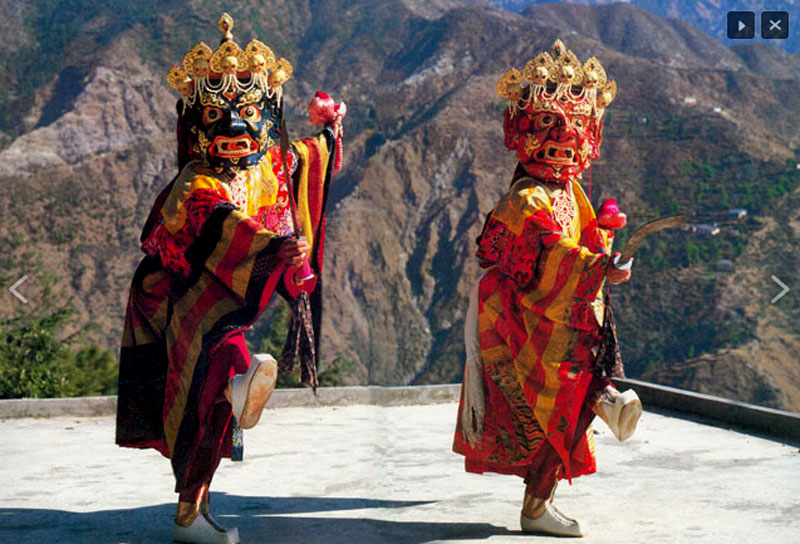

Namgyal Monastery is the personal monastery of His Holiness Dalai Lama, and also includes Namgyal Tantric College.
Namgyal Monastery in Tibet
His Holiness the Third Dalai Lama, Sonam Gyatso, founded Namgyal Monastery in 1574, at Drepung Gaden Palace. The monastery was founded in order to assist the Dalai Lama in his religious activities. Its original name was Phende Lekshey Ling.
However, four years later, in 1576, the Third Dalai Lama established a priest-patron relationship with the Mongol King, Altan khan, and His Holiness instructed the monastery to perform the Vijaya Long-Life ritual for Altan Khan, in order to prolong his life. Vijaya is known as Namgyal Ma the victorious goddess) in Tibetan, and consequently the monastery was re-named Namgyal (Victorious) Dratsang (Monastic College).
His Holiness the Great Fifth Dalai Lama, Ngawang Lobsang Gyatso (1617-1682) extended and enhanced the religious activities of the monastery by introducing many new elements of tantric rites and rituals into its tradition. Later the monastery was also entrusted with the responsibility for performing various important prayers and rituals for the welfare and prosperity of the Tibetan Government.
The tradition of performing the four major tantric rites — Guhyasamaja, Chakrasamvara, Yamantaka, and the unique rite of the Kalachakra — was instituted during the time of His Holiness the Seventh Dalai Lama, Kalsang Gyatso (1708-1757). Since that time the monastery has also been known as the Kalachakra Monastery and the number of the monks were fixed to one hundred and seventy five. Then the monastery was moved into the Potala Palace, the winter residence of the Dalai Lama, where it was better able to serve the needs of both the Dalai Lama and the Tibetan Government by performing important ritual prayers and ceremonies.
In 1751, after the establishment of the Kashag (the equivalent of the Cabinet in the Tibetan Government), His Holiness also recognised the special responsibility of Namgyal monks by conferring various ranks of monk official (tse-kor) on them. Since that time, the monastery has had the honour and responsibility of serving the successive Dalai Lamas and the Tibetan Government.
Namgyal Monastery in India
In 1959, the Red Chinese invaded Tibet. After the unsuccessful popular uprising against Chinese rule, His Holiness the Fourteenth Dalai Lama and approximately one hundred thousand Tibetans, including fifty-five Namgyal monks, fled into the neighbouring countries of Nepal, Bhutan, and India. His Holiness then re-established Namgyal Monastery in India, and a small group of new, young monks from various Tibetan refugee schools joined those Namgyal monks from Tibet who had survived the desperate early years as refugees. Thus the monastery’s ancient rituals, artistic skills and traditions — making butter sculptures, constructing coloured sand mandalas, performing sacred monastic dance, ritual music, and chanting — were gradually preserved and revived.
Namgyal Monastery was rebuilt near the residence of His Holiness the Dalai Lama in Dharamshala and has managed to continue its program of studies and ritual practices under the very guidance of His Holiness. The monastery has nearly two hundred monks.
Younger monks are engaged in study of the major texts of Buddhist Sutras and Tantras, while at the same time pursuing the modern studies of both Tibetan and English Language. Their curriculum includes the study of Sutra and Tantra texts, Buddhist Philosophy, and practising debate, as well as making butter sculptures, torma offerings, sand mandalas, playing various ritual musical instruments, ritual chanting, and dances.
Unlike other Tibetan monasteries, Namgyal Monastery has a unique mandate. It is the personal monastery of His Holiness the Dalai Lama, and as such is non-sectarian and responsible for maintaining ritual practices and teachings of all the four main lineages of Tibetan Buddhism. The monastery is especially privileged and honoured to perform annually the sacred rites and rituals established by the successive Dalai Lamas for the temporal and spiritual benefits and prosperity of Tibet and its people, and for world peace in general.
རྣམ་རྒྱལ་གྲྭ་ཚང་གི་ལོ་རྒྱུས་མདོར་བསྡུས།
༄༅།།སྐུ་བཅར་རྣམ་རྒྱལ་གྲྭ་ཚང་ཕན་བདེ་ལེགས་བཤད་གླིང་ཞེས་པའི་གྲྭ་ཚང་འདི་ནི་༸རྒྱལ་མཆོག་སྐུ་ཕྲེང་གཉིས་པ་དགེ་འདུན་རྒྱ་མཚོའི་(1476-1542) དུས་སྐབས་ནས་ཕྱི་ལོ་ ༡༥༠༩ ལོར་ཆོས་འཁོར་རྒྱལ་གྱི་གཙུག་ལག་ཁང་དུ་གཞི་བ་གྲྭ་ཚང་དང༌། དྭགས་བྱེས་གྲྭ་ཚང༌། མངའ་རིས་གྲྭ་ཚང༌། སྒར་པ་གྲྭ་ཚང༌། རྣམ་རྒྱལ་གྲྭ་ཚང་བཅས་གྲྭ་ཚང་ལྔ་ཕྱག་འདེབས་མཛད་པ་ལས། རྣམ་རྒྱལ་གྲྭ་ཚང་འདི་ཉིད་ཆོས་ཕྱོགས་ནས་༸རྒྱལ་དབང་གང་ཉིད་ཀྱི་རིམ་གྲོ་ཞབས་ཞུར་ཆེད་དམིགས་ཀྱིས་ཕྱབ་བཏབ་ཅིང་། དེ་རྗེས་༸རྒྱལ་མཆོག་སྐུ་ཕྲེང་གསུམ་པ་བསོད་ནམས་རྒྱ་མཚོས་(1543-1588) རབ་བྱུང་བཅུ་པའི་ཤིང་ཁྱི་ལོ་སྟེ་ཕྱི་ལོ་༡༥༧༤ ལོར་ཡོངས་གྲགས་སུ་ཕྱག་བཏབ་སྟེ། ཕན་བདེ་ལེགས་བཤད་གླིང་ཞེས་མཚན་གསོལ་གཟེངས་བསྟོད་ཀྱི་བཀའ་དྲིན་སྩལ་བ་མ་ཟད། ཨལ་ཐན་ཆོས་ཀྱི་རྒྱལ་པོའི་སྐུ་ཚེ་བསྲིང་ཐབས་སུ་སྐུ་གཞོགས་གྲྭ་ཚང་ཕན་བདེ་ལེགས་བཤད་གླིང་པར་གཙུག་ཏོར་རྣམ་པར་རྒྱལ་མའི་ཆོ་ག་གསར་འཛུགས་གནང་བ་ལ་བརྟེན་ནས་རྣམ་རྒྱལ་གྲྭ་ཚང་ཞེས་ཡོངས་སུ་གྲགས། དེ་ནས་༸གོང་ས་ལྔ་པ་ཆེན་པོའི་(1617-1682) སྐུ་དུས་སུ་གྲྭ་ཚང་དུ་སྔགས་ཕྱོགས་ཀྱི་ཆོ་ག་ཕྱག་ལེན་མང་པོ་གསར་འཛུགས་བསྐྱངས་ཏེ་སྔར་ལས་ཡར་རྒྱས་སུ་གཏོང་གནང་མཛད། ལྷག་པར་༸གོང་ས་ལྔ་པ་ཆེན་པོས་བོད་ཡོངས་ལ་མངའ་དབང་བསྒྱུར་བ་༼༡༦༤༢༽ནས་བཟུང་གྲྭ་ཚང་ནས་ཆོས་ཕྱོགས་ཀྱི་གསུང་ཞབས་ཞུ་སྒོ་སྨོས་མེད་ཐོག བོད་གཞུང་དགའ་ལྡན་ཕོ་བྲང་པའི་བསྟན་སྲིད་བདེ་ཐབས་སོགས་སྐབས་བབས་ཞབས་རིམ་གལ་ཆེ་སྣེ་མང་འཕྲལ་འཕྲལ་བསྒྲུབ་དགོས་པའི་དབང་གིས་འབྲས་སྤུངས་དགའ་ལྡན་ཕོ་བྲང་ནས་༸གོང་ས་མཆོག་གཏན་བཞུགས་གནང་ཡུལ་རྩེ་ཕོ་བྲང་དུ་སྤོ་བཞུགས་མཛད། དེའི་ཚེ་ཆོས་ཕྱོགས་ནས་གྲྭ་ཚང་དུ་རྟོགས་པའི་ཡོན་ཏན་ལ་མངའ་བརྙེས་པའི་སྐྱེས་བུ་དམ་པའང་མང་དུ་བྱོན་པ་དང་། སྲིད་ཕྱོགས་ནས་༸རྒྱལ་བའི་འཕྲིན་ལས་ཀྱི་ཞབས་འདེགས་པ་མཆོད་དཔོན་ངག་དབང་ཤེས་རབ་དང་། དབུ་མཛད་སློབ་བཟང་བསྟན་འཛིན། སྡེ་སྲིད་ཆོས་དཔོན་བློ་བཟང་མཐུ་སྟོབས། སྡེ་སྲིད་བློ་བཟང་སྦྱིན་པ་༼གྲྭ་ཚང་གི་གཉེར་པ།༽སོགས་ཀྱིས་སྡེ་སྲིད་ཀྱི་ལས་འགན་འཁུར་དུ་བཟོད་པར་མཛད་པ་སོགས་བོད་གཞུང་གི་བསྟན་པ་ཆབ་སྲིད་ལ་གཅིག་ཏུ་ལྷག་བསམ་དཀར་ཞིང་མཁས་མཛངས་ལྡན་པའང་མང་དུ་བྱུང་། དེ་དག་གི་བྱུང་བ་ཞིབ་པ་ནི་༸གོང་ས་ལྔ་པའི་མཛད་རྣམ་དུ་ཀཱུ་ལའི་གོས་བཟང་དུ་གསལ་བ་ལྟར་ལགས་ཤིང་། སྐུ་ཕྲེང་དྲུག་པའི་(1683-1706) སྐབས་དུས་འགྱུར་དབང་གིས་གྲྭ་ཚང་འདི་ཉིད་རེ་ཞིག་འཐོར་རྐྱེན་དུ་སོང་ཡང་། སླར་༸རྒྱལ་མཆོག་བདུན་པ་ཆེན་པོས་(1708-1787)རྒྱུད་གྲྭ་སྨད་སྟོད་སོགས་ནས་དགེ་འདུན་པ་དྲག་སྒྲུག་གིས་གསང་བདེ་འཇིགས་གསུམ་དང་། ལྷག་པར་དཔལ་དུས་ཀྱི་འཁོར་ལོའི་ཆོ་ག་ཕྱག་ལེན་གསར་འཛུགས་དང་འབྲེལ་གྲྭ་གྲངས་བརྒྱ་དང་བདུན་ཅུ་དོན་ལྔའི་གྲངས་བཅད་ཀྱང་མཛད། བོད་གཞུང་བཀའ་ཤག་གསར་འཛུགས་གནང་བ་དང་ཆབས་ཅིག། གྲྭ་ཚང་སྐུ་ཞབས་རྣམས་ལའང་གཟིགས་བཟོས་སུ་གཞུང་ཞབས་རྩེ་སྐོར་གྱི་གོ་གནས་མཐོ་དམའ་རིམ་པ་མང་པོ་སྩལ། དེ་ནས་བཟུང་༸རྒྱལ་བའི་ཆོས་ཕྱོགས་ཞབས་ཞུ་དང་། བོད་གཞུང་གི་བསྟན་སྲིད་ཞབས་རིམ་བཀའ་འབྲེལ་དུས་ཐོག་སྨིན་སྒྲུབ་མི་ལོ་བརྒྱ་ཕྲག་ཁ་ཤས་རིང་གཟེངས་སུ་ཐོན་པར་ཞུས་དང་ཞུ་མུས་སུ་མཆིས། ཕྱི་ལོ་ ༡༩༥༩ ལོར་བོད་དུ་དུས་འགྱུར་མི་བཟད་པ་བྱུང་བའི་སྐབས་༸གོང་ས་མཆོག་གི་ཕེབས་རྗེས་སུ་གྲྭ་ཚང་གི་སྐུ་ཞབས་ཉུང་ཤས་ཤིག་ཕེབས་ཐུབ་པ་རྣམས་སྐབས་ཤིག་རིང་མ་སུ་རི་དང་། ཊ་ལ་ཧོ་སི་སོགས་ལ་སྐུ་ངལ་གྱི་ངང་དུ་བཞུགས་མུས་སུ། ཕྱི་ལོ་ ༡༩༦༡ ལོར་༸གོང་ས་མཆོག་ནས་ཆོས་ཕྱོགས་ཞབས་ཞུར་ཚང་མ་བཞུགས་སྒར་དྷ་སར་བཀའ་འགུགས་ཐོག སློབ་གྲྭ་ཁག་ནས་གསར་ཞུགས་མི་ཉུང་བ་ཞིག་ཀྱང་སྒྲིག་ཁོངས་སུ་བཅུག་སྟེ། གྲྭ་ཚང་གི་སྔར་སྲོལ་སྒྲིག་ལམ་ཀུན་སྤྱོད་དང་། སྒྲུབ་མཆོད་ཁག དཀྱིལ་འཁོར་འབྲི་ཐིག གཏོར་བཟོ་དཀར་རྒྱན། དུང་རྒྱ་རྐང་གླིང་། གར་འཆམ་སོགས་བསྐྱར་གསོ་བཀའ་དྲིན་ཆེ་ཐོག ཕྱི་ལོ་༡༩༧༠ ལོར་མདོ་སྔགས་གཞུང་ཆེན་འཛིན་རིམ་བཅུ་གསུམ་བར་གྱི་བཤད་གྲྭ་གསར་འཛུགས་བཀའ་དྲིན་སྩལ་བས་ད་ལྟ་མདོ་སྔགས་གང་ས་ནས་བསྔགས་འོས་ཀྱི་གནས་སུ་གྱུར་ཡོད་པ་མ་ཟད། ཕྱི་ལོ་༢༠༡༢ ལོར་སྤྱི་ནོར་༸གོང་ས་༸སྐྱབས་མགོན་ཆེན་པོ་མཆོག་ལ་སྙན་གསེང་བཀའ་འཁྲོལ་གྱིས་ལམ་སྟོན་གཞིར་བཟུང་།
ལོ་རིམ་དང་པོ། བསྡུས་གྲྭ་ཆུང་འབྲིང་།
ལོ་རིམ་གཉིས་པ། བསྡུས་གྲྭ་ཆེ་བ།
ལོ་རིམ་གསུམ་པ། བསྡུས་གྲྭ་ཆེ་བ།
ལོ་རིམ་བཞི་པ། གྲུབ་མཐའ་བྱེ་མདོ།
ལོ་རིམ་ལྔ་པ། གྲུབ་མཐའ་སེམས་ཙམ།
ལོ་རིམ་དྲུག་པ། ཕར་ཕྱིན་ལོ་རིམ་དང་པོ།༼ས་ལམ་དང་།དོན་བདུན་ཅུ།༽
ལོ་རིམ་བདུན་པ། ཕར་ཕྱིན་ལོ་རིམ་གཉིས་པ།༼སེམས་བསྐྱེད་དང་། བདེན་གཉིས། རིགས་ཀྱི་རྣམ་གཞག༽
ལོ་རིམ་བརྒྱད་པ། ཕར་ཕྱིན་ལོ་རིམ་གསུམ་པ།༼བདེན་བཞི་དང་།རྟེན་འབྲེལ།སྐྱབས་གསུམ།༽
ལོ་རིམ་དགུ་པ། གྲུབ་མཐའ་དབུ་མ།
ལོ་རིམ་བཅུ་པ། དྲང་ངེས་དབུ་མ།
ལོ་རིམ་བཅུ་གཅིག ལམ་རིམ་ལྷག་མཐོང་ཆེ་ཆུང་།
ལོ་རིམ་བཅུ་གཉིས། སྔགས་རིམ་རྒྱུད་སྡེ་འོག་མ་གསུམ།
ལོ་རིམ་བཅུ་གསུམ། ཡེ་ཤེས་རྡོ་རྗེ་ཀུན་ལས་བཏུས་པ།
ལོ་རིམ་བཅུ་བཞི། སྔགས་རིམ་དབང་དང་བསྐྱེད་རིམ།
ལོ་རིམ་བཅོ་ལྔ་པ། སྔགས་རིམ་ཆེན་མོ་རྫོགས་རིམ།
བཅས་སྔར་ཡོད་འཛིན་རིམ་བཅུ་གསུམ་ཐོག་འཛིན་རིམ་བཅོ་ལྔ་བར་སྤར་ཆ་གནང་སྟེ་སློབ་ཚན་གཏན་འབེབས་ཀྱིས་སྔར་ལས་ཀྱང་འཐུས་སྒོ་ཇེ་ཚང་དུ་གྱུར་ཡོད། དེ་འབྲེལ་ཕྱི་རྒྱལ་སྤྱི་སྒེར་ཁག་ནས་གདན་ཞུ་བྱུང་འཕྲལ་མདོ་སྔགས་ཀྱི་གཞུང་ལ་སྦྱང་པ་ལེགས་གྲས་རྣམས་ཕྱོགས་བསྐྱོད་ཀྱིས་དཀྱིལ་འཁོར་འབྲི་བཞེངས་དང་། གར་འཆམ། ནང་ཆོས་ཀྱི་སློབ་སྟོན་སོགས་བོད་ཀྱི་ཆོས་དང་རིག་གཞུང་ཕྱོགས་བརྒྱར་སྤེལ་བའི་ཐབས་ཚུལ་ཞུ་མུས་སུ་མཆིས་ཤིང་། དེ་དག་གི་ནང་ནས་གཞོན་གྲས་རྣམས་ཀྱིས་མདོ་སྔགས་གཞུང་ཆེན་ཁག་ལ་ཐོས་བསམ་སློབ་གཉེར་མུ་མཐུད་མཛད་བཞིན་པའི་ཐོག བོད་ཀྱི་ཐ་སྙད་རིག་གནས་དང་། འཛམ་གླིང་སྤྱིའི་ཤེས་བྱ་ཁག་ལའང་སྦྱང་བརྩོན་ཞུ་བཞིན་ཡོད། དེ་མཚུངས་ཉེ་བའི་ལོ་ངོ་བཅུ་ཕྲག་ཁ་ཤས་ཀྱི་གོང་ཕྱི་རྒྱལ་ནང་ཆོས་ལ་དོན་གཉེར་ཅན་མང་པོས་རེ་བསྐུལ་བྱུང་བ་ལྟར་ཨ་རི་ནེའུ་ཡོག་མངའ་སྡེའི་ས་གནས་ཨི་ཐི་ཀར་བོད་ཀྱི་ཆོས་དང་རིག་གཞུང་གི་བསྟི་གནས་ ༼རྣམ་རྒྱལ་གྲྭ་ཚང་ནང་ཆོས་སློབ་གཉེར་ཁང་དང་། དུས་འཁོར་ཆོས་གླིང་༽ གཉིས་སུ་སློབ་ཐོན་པ་སྐུ་ཞབས་བཞི་ཆེད་གཏོང་གིས་གསར་འཛུགས་ལེགས་གྲུབ་ཟིན་ཡོད་ཅིང་། ད་ལྟའི་འཆར་ལས་རིམ་དངོས་གཞིའི་ནང་གོམ་པ་སྤོ་འགོ་ཚུགས་ཏེ་དོན་གཉེར་ཆེ་བའི་ཕྱི་རྒྱལ་སློབ་ཕྲུག་རྣམས་ལ་ནང་ཆོས་སློབ་འཁྲིད་ཀྱིས་ཞབས་ཞུ་སྒྲུབ་བཞིན་པ་བཅས་ཀྱི་ལོ་རྒྱུས་མདོར་བསྡུས་སུ། །
གསང་ཆེན་རྣལ་འབྱོར་དབང་གི་རྒྱལ་པོ་ལ། །
ཅི་དགར་སྤྱོད་མཛད་རྣམ་པར་རྒྱལ་བའི་སྡེ། །
མི་ཉམས་རྒྱས་ཤིང་མདོ་སྔགས་བསྟན་པའི་གནད། །
ཚུལ་བཞིན་སྤྱོད་པའི་བསྟན་འཛིན་འཕེལ་གྱུར་ཅིག །

